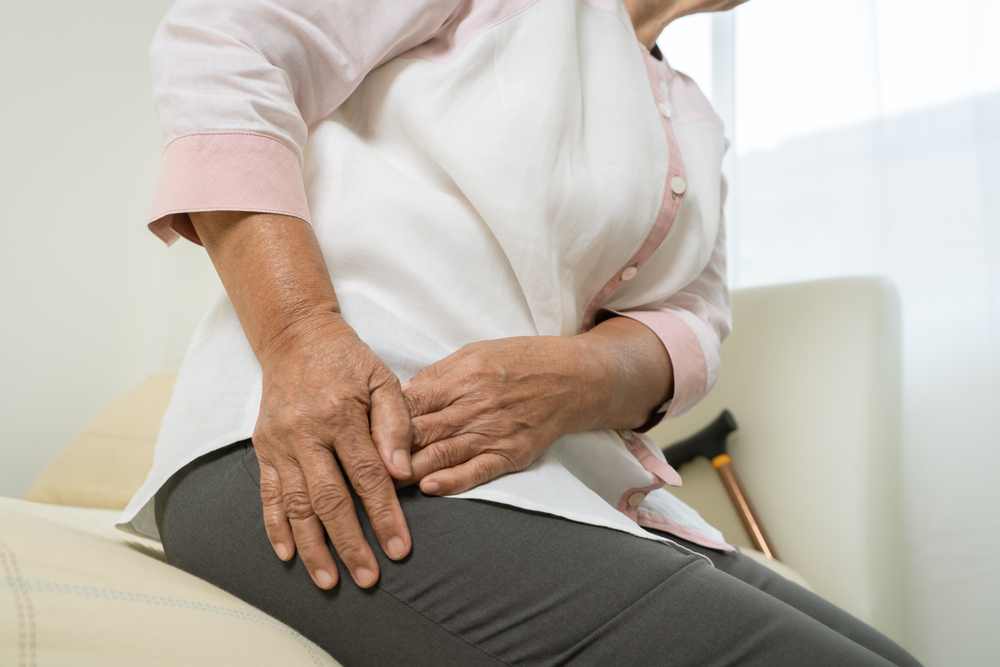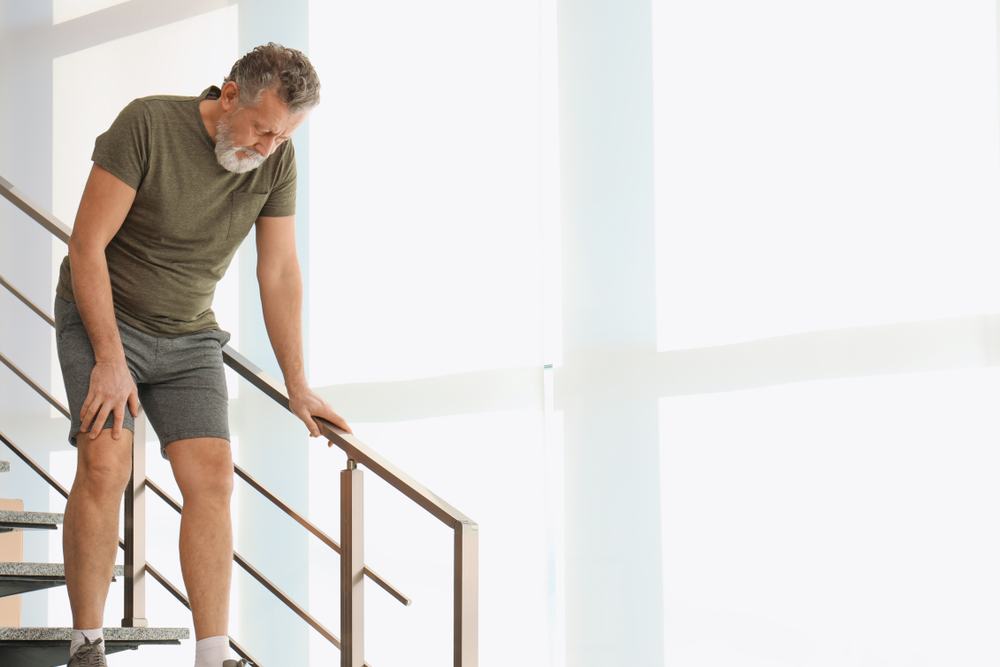What Is Osteoarthritis?
 Arthritis refers to the painful swelling of the joints. While there are multiple forms of arthritis–over a hundred!–the most common is osteoarthritis. It is also called degenerative joint disease. Osteoarthritis is caused by the normal wear and tear of your body over time.
Arthritis refers to the painful swelling of the joints. While there are multiple forms of arthritis–over a hundred!–the most common is osteoarthritis. It is also called degenerative joint disease. Osteoarthritis is caused by the normal wear and tear of your body over time.
The ends of the bones that connect at the joint are cushioned by cartilage. The cartilage’s job is to absorb shock and ensure that joints move without friction. Over time, the cartilage can deteriorate until it wears away completely, causing the bones to rub against each other painfully. This is the condition known as osteoarthritis. One of the most common forms occurs in the knees. Between 10% and 13% of people aged 60 or older are affected by symptoms that come with knee osteoarthritis. That rate is about 7.5% for hip osteoarthritis.
While young people can develop arthritis, the chances of experiencing arthritis increase exponentially after age 45. Weight, genetics, gender, and participation in athletics are all risk factors for developing osteoarthritis.
Arthritis Symptoms
 Most people first suspect they have arthritis when they begin to experience chronic pain in their joints. This pain is worst at the end of the day or during or after an activity with a lot of movement. You are also likely to experience stiffness or a limited range of motion, especially in the morning or after a period of rest. Swelling, tenderness, and weakness near the joint are also common symptoms.
Most people first suspect they have arthritis when they begin to experience chronic pain in their joints. This pain is worst at the end of the day or during or after an activity with a lot of movement. You are also likely to experience stiffness or a limited range of motion, especially in the morning or after a period of rest. Swelling, tenderness, and weakness near the joint are also common symptoms.
Knee arthritis is often accompanied by crepitus, a creaking sound audible when the joint bends. Knees and hips can make clicking or popping sounds when the joints are used. Many people with arthritic knees or hips also notice a degree of instability, causing problems like buckling, where the knee gives out unexpectedly.
Treating Arthritis
 Osteoarthritis can be a burdensome condition, causing pain as you complete everyday tasks that were once painless. One possible treatment option is joint replacement surgery; however, artificial joints can wear just like natural ones and often need to be replaced. Surgery may also be a frightening idea for some. The good news is that there are a number of highly effective non-surgical treatments that can help limit the symptoms of osteoarthritis.
Osteoarthritis can be a burdensome condition, causing pain as you complete everyday tasks that were once painless. One possible treatment option is joint replacement surgery; however, artificial joints can wear just like natural ones and often need to be replaced. Surgery may also be a frightening idea for some. The good news is that there are a number of highly effective non-surgical treatments that can help limit the symptoms of osteoarthritis.
Medication
The first recommendation a doctor is likely to make for pain management related to arthritis is medication. You can start with over-the-counter painkillers but may need stronger prescription medications as your pain increases. There are different classes of pain medication, each of which carries its own benefits and drawbacks.
NSAIDs
Nonsteroidal anti-inflammatory drugs (NSAIDs) work by blocking an inflammation-producing enzyme, leading to reduced swelling and pain. Common forms include ibuprofen (Advil and Motrin), aspirin, and naproxen sodium (Aleve).
Although many of these medications can be purchased without requiring a prescription and can be taken safely for a short time, it is important to pay attention to the label. NSAIDs can produce stomach ulcers and other digestion-related side effects. Long-term usage can result in kidney failure and even stroke or heart disease. NSAIDs should not be taken for a long period of time without checking in with a doctor. You should not take NSAIDs if you are allergic to aspirin or if you have kidney disease.
Some NSAIDs must be prescribed. Your doctor can recommend the best options for you, depending on your medical history and other factors.
Oral Analgesics
Analgesics do not target inflammation. Instead, they block the receptors in your body that recognize pain. The most commonly found analgesic is over-the-counter acetaminophen (Tylenol). The FDA recommends no more than 4,000 mg per day of acetaminophen. Taking high doses of acetaminophen for a long period of time can be fatal, especially if you drink alcohol in excess while using the medication.
Topical Analgesics
Like their oral partners, these medications address pain by blocking pain signals in your body. They can come in ointment, cream, gel, or patch form. Some are available over the counter, while others must be prescribed. Capsaicin, diclofenac sodium, methyl salicylate and menthol (Bengay), and trolamine salicylate are all options for these topical pain medications. Topical capsaicin is recommended, particularly for knee arthritis.
Corticosteroids
Also called steroids, this form of medication is intended for short-term use during severe flare-ups of osteoarthritis. Similar to NSAIDs, steroids reduce inflammation. For osteoarthritis treatment, the medication is delivered through injection directly into the affected joints. While very effective in small doses, long-term usage carries many negative side effects. This includes high blood sugar, stomach ulcers, high blood pressure, mood changes, cataracts, and decreased bone density.
Opioids
Opioids, a powerful but sedating and habit-forming class of drugs, work by blocking pain signals from being sent to the brain. While they are extremely helpful for acute cases of severe pain, doctors are hesitant to prescribe them due to long-term use. In recent years, Americans have been faced with a national epidemic of opioid abuse, often resulting in overdose-related use. As a result, they are mostly used as last resort options for infrequent but significant pain or for post-operational recovery. Tramadol is the recommended opioid of choice for managing knee and hip arthritis.
Assistive Devices
Osteoarthritis can make a big impact on your ability to complete daily activities for independent living. The pain may be so great that things that used to come easily to you, like walking, cooking, using the bathroom, or even getting dressed, suddenly seem to take much longer and have become much more difficult. Assistive devices are tools intended to make these tasks easier to complete.
Walking
Knee and hip arthritis can often make walking extremely painful. One of the simplest ways to address this is by wearing custom shoes or using orthotic shoe inserts. This can help with providing more shock absorption in the feet, doing one of the jobs that joints would otherwise do. Mobility aids like canes, crutches, walkers, and rollators can help by taking on some of your weight so that your knees and hips do less work. It is important that if you do choose to use a mobility aid that you are fitted properly by a medical professional, as a misfit or untrained use can make your condition worse.
Environmental Modifications
Your home should be a safe haven where you can experience the least possible pain. Ensure that floors remain clear and remove rugs or use rug pads. Use furniture that is easy for you to get into and out of, or adjust the height by adding risers. You can use a wheeled cart in the kitchen to transport hot dishes so that there is no risk of spilling. In the bathroom, install grab bars near the tub and toilet to ensure that you do not slip. Raising the toilet seat will help ease the pain of arthritis in both the hips and the knees.
Other Daily Functions
People with hip or knee arthritis should avoid using stairs if possible. Walking up stairs puts particular stress on both your knee and hip joints, causing increased pain. If you must walk up stairs, use a handrail and go slowly.
Dressing can be difficult for those with hip or knee arthritis. Shoes are a particular struggle. One popular tool for managing this is a shoehorn with an extended handle. This will allow you to put on your shoes and socks without bending over.
Modified Exercise
Arthritic pain in your hips and knees can make some forms of exercise feel impossible. However, daily movement, any way you can get it, is necessary for everyone, including patients with arthritis. Not only does exercise help with stiffness and pain from arthritis, but it can also be a protective factor against mental illness and delay the onset of some diseases that often occur in older age, including Alzheimer’s disease.
For overall aerobic fitness, the best forms of exercise are low-impact and easier on the joints. That means losing the daily run and replacing it with swimming, bicycling, or using an elliptical machine. If you are starting a new exercise routine, go slowly. Pushing yourself too hard can worsen your pain or even result in injury. Make sure to stretch and begin with gentle range-of-motion exercises to warm up your joints.
Temperature Therapy
Both heat and cold can have positive, though different, effects on arthritic pain. You can use either one and switch between both heat and cold within a day or throughout the week.
Applying heat can help your joints and the surrounding muscles relax by increasing blood circulation. You can use warm towels, heating pads, or even a stream of hot water from the faucet. The heat should be warm and can be applied for twenty minutes every three to four hours. Applying heat is a good idea before participating in any movement.
Ice reduces inflammation and swelling. It is especially useful for managing post-exercise pain or during a bad flare-up. You can apply cold using an ice pack for twenty minutes every three to four hours.
Physical Therapy
Physical therapy is one of the most effective treatments for reducing pain and increasing the degree of independent living that people with arthritis may enjoy. When you participate in physical therapy, a specially trained physical therapist will support your goals for improved mobility and flexibility and reduced pain by providing both active and passive treatments. Passive treatments do not necessarily need work from the patient; for these treatments, therapists use a variety of tools to support your needs. As tension and pain begin to reduce, they may work with you on more active treatments, in which you will participate in stretches and exercises.
Passive Treatments
Some of the tools and technologies physical therapists may use to help your pain include providing temperature therapy (described above) or hydrotherapy. Hydrotherapy relies on the use of water to help facilitate motion without putting weight on your joints. Hydrotherapy helps with quickly increasing mobility without increasing the level of accompanying pain. A physical therapist may also massage the muscles around the joints to help reduce tension and promote mobility.
Active Treatments
The goals of strength, endurance, flexibility, and mobility are achieved through gentle movement. Your physical therapist will identify and adapt a combination of stretches and exercises that will help to reach these goals and reduce pain. They will work with you on the proper way to do the exercises, and you will most likely be expected to continue practicing on your own time at home. Remembering to consistently make time for your physical therapy is the best way to ensure that physical therapy is effective.
Strengthening exercises will be an important area of focus in your physical therapy sessions. Your physical therapist will walk you through a routine that will build muscle – and thus better protection around the joints – in your hips or knees. This may be accomplished through resistance work or weight training. Your therapist may also teach you how to use certain weight machines.
Your physical therapist will also work with you on increasing your flexibility with stretches and range of motion exercises. These will help reduce the stiffness you experience after rest and will make it easier for you to engage in regular movement. It will also help your knees or hips function better, reducing some of the pain you may feel when walking.
Weight Loss
According to some research, even minor weight loss can make a positive impact on your experience of osteoarthritis. For example, in one study, a 10% loss of body weight resulted in less compression on the joints, resulting in reduced pain. In another smaller study, patients with hip arthritis who participated in a weight loss program reported an improvement rate of around 30% after eight months of being enrolled in the program.
Weight loss can also prevent the need for surgery. In a 2021 study, for every 1% of body weight lost, there was a 2% reduction in risk of knee replacement and a 3% reduction in risk of hip replacement. This was true regardless of the BMI each of the participants started with.
In general, the combination of regular movement and healthy habits are a good goal for any patient managing arthritis. By engaging consistently in strengthening, flexibility, and aerobic exercise, and by eating a balanced diet with adequate nutrition, you can improve your day-to-day well-being.
